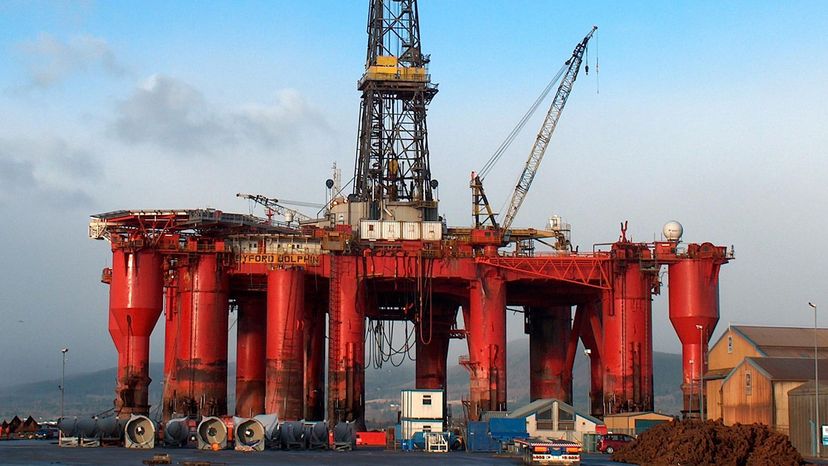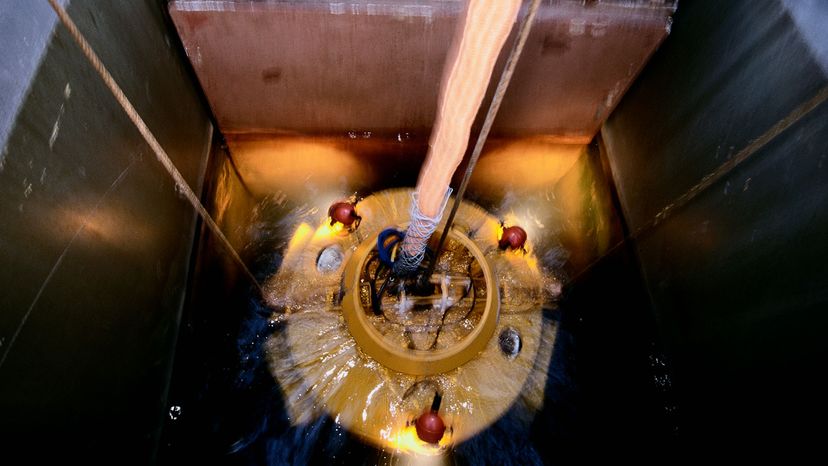
Key Takeaways
- In 1983, a tragic accident on the Byford Dolphin oil rig resulted in explosive decompression, instantly killing four saturation divers and critically injuring another crew member.
- The rapid decompression occurred when a diving bell prematurely detached from its chamber due to unsealed chamber doors.
- The incident revealed severe flaws in safety protocols and led to significant improvements in commercial diving operations and safety standards worldwide.
Saturation divers are professional deep-sea divers who descend to depths of 500 feet (152 meters) or more to service equipment on offshore oil rigs and undersea pipelines. But unlike most commercial divers, who do a few hours of work underwater and return to the surface, saturation divers will spend up to 28 days on a single job, living in a cramped high-pressure chamber where they eat and sleep between shifts.
Pay is great for saturation divers — between $30,000 and $45,000 a month — but it's intense work in an otherworldly and claustrophobic environment. And it can be dangerous. In 1983, four saturation divers and one crew member were killed in a gruesome accident aboard a Norwegian-operated oil rig called the Byford Dolphin.
Advertisem*nt
The Byford Dolphin catastrophe was a wake-up call for the commercial diving industry, which responded with tighter safety measures to ensure that no one else would meet such a terrible fate. Before we explain what happened, here's a little info on decompression sickness or "the bends."
Advertisem*nt
Contents
- Why 'The Bends' Are Bad News
- How Saturation Divers Stay Under for So Long
- A Routine Procedure Gone Horribly Wrong
- Hard Lessons Learned and Delayed Justice for the Families
Why 'The Bends' Are Bad News
Since scuba diving was first invented in the 1940s, divers have learned a lot about how to safely swim to great depths, sometimes the hard way. As a diver descends, the weight of the water around them applies pressure to every cell in their body. The pressure even compresses molecules of gaseous nitrogen taken in by the lungs, which causes the nitrogen gas to dissolve into the bloodstream.
The absorption of nitrogen itself isn't the issue. The problem starts if a diver tries to ascend to the surface too quickly. Think of it like shaking a 2-liter bottle of soda and opening the cap. The gasses that were contained under pressure instantly form bubbles and expand.
That's pretty much what happens inside a diver's body when they suffer decompression sickness or "the bends." If they ascend too quickly from the high pressure of the deep water to the much lower pressure at the surface, the nitrogen molecules that had dissolved under pressure quickly expand and become gaseous again.
"Nitrogen bubbles will form in the bloodstream and those can prevent the circulation of blood, including to the heart," says Phillip Newsum, an experienced commercial diver and executive director of the Association of Diving Contractors International. "That's when you run the risk of getting decompression sickness."
Decompression sickness or "the bends" is a painful and potentially fatal condition that can cause excruciating joint and muscle pain, delirium, paralysis, heart attacks and strokes. If caught quickly enough, the bends can be treated by placing the individual back under pressure in a special tank called a hyperbaric chamber and slowly releasing the pressure over a matter of hours or days.
But the best strategy is to avoid decompression sickness altogether by slowly ascending to the surface and taking frequent breaks to let your body naturally exhale or "off gas" the nitrogen. Certified SCUBA divers know how to read a recreational dive planner that tells them when to take safety breaks during an ascent and for how long.
Commercial divers, however, are asked to work at depths far beyond what any recreational SCUBA diver would dare to attempt. As we'll see next, that requires a whole different type of decompression, and it was a failure in that system that led to the violent deaths of the Byford Dolphin divers.
Advertisem*nt
How Saturation Divers Stay Under for So Long
The deeper you dive and the longer you stay underwater, the more nitrogen gets dissolved in your bloodstream. Eventually, a diver's body becomes "saturated" with dissolved nitrogen, which is how saturation divers get their name.
Saturation divers work at depths as great as 1,000 feet (304 meters). If they used the same technique as recreational divers to safely decompress — slowly ascending with long pauses — it would take them days to reach the surface.
Advertisem*nt
Instead, saturation divers are shuttled to the surface in pressurized diving bells and then transferred into specialized decompression chambers. For every 100 feet (30 meters) that a saturation diver descends, they need to spend approximately one day in the chamber, where they chill on cots, watch movies and receive food through pressurized slots.
The problem is that it's not economical for an oil company to pay saturation divers for a few hours of work and several days of rest. And interestingly, once you reach saturation level, your body can't absorb any more nitrogen no matter how long you stay underwater. So instead of decompressing after each dive, saturation divers just stay at pressure.
For up to 28 days — the industry maximum — saturation divers will commute to the depths in those pressurized diving bells. But instead of entering a decompression chamber on the surface, they bunk up inside of a hyperbaric chamber that maintains their bodies at the same pressure level as the deep water.
"We call that the storage depth," says Newsum, whose organization helps to establish international safety standards for commercial diving. "By staying compressed, they can work out there for as long as they need to, and when you bring them back up, you don't need to worry about decompression."
That is, until the job is done. The last week of any saturation diving job is reserved for slow and steady decompression before finally leaving the cramped quarters and breathing fresh air again.
Advertisem*nt
A Routine Procedure Gone Horribly Wrong
It takes a whole crew to make a saturation diving operation work.
Life support technicians ensure that the air mix in the hyperbaric chamber matches the air that the divers breathe underwater. The dive control team is in charge of operating the diving bell — which raises and lowers on a crane — and monitoring the divers as they work. There are even cooks that prepare and serve meals to the men cooped up in the living chambers.
Advertisem*nt
Workers called "tenders" have a very important support job. They help unspool and retract the "umbilical," the thick line of air supply tubes and communication wires that connects the divers to the surface. In the past, tenders had other responsibilities that included docking the diving bell to the pressurized living chambers.
"The saturation divers are completely at the mercy of the tender and of their supervisors on the dive control team," says Newsum.
On Nov. 5, 1983, an experienced tender named William Crammond was in the middle of a routine procedure aboard the Byford Dolphin, a semi-submersible oil rig operating in the North Sea. The rig was equipped with two pressurized living chambers, each holding two divers. Crammond had just connected the diving bell to the living chambers and safely deposited a pair of divers in chamber one. The other two divers were already resting in chamber two.
That's when things went horribly wrong. Under normal circ*mstances, the diving bell wouldn't be detached from the living chambers until the chamber doors were safely sealed shut. However, the diving bell detached before the chamber doors were closed, creating what's known as an "explosive decompression."
"It's a death sentence," says Newsum. "You won't survive."
The air pressure inside the Byford Dolphin living chambers instantly went from 9 atmospheres — the pressure experienced while hundreds of feet below the water — to 1 atmosphere, the normal air pressure at the surface. The explosive rush of air out of the chamber sent the heavy diving bell flying, killing Crammond and critically injuring his fellow tender, Martin Saunders.
The fate of the four saturation divers inside was far worse. According to autopsy reports, three of the men inside the chamber — Edwin Arthur Coward, Roy P. Lucas and Bjørn Giæver Bergersen — were essentially "boiled" from the inside when the nitrogen in their blood violently erupted into gas bubbles. They died instantly.
The fourth diver, Truls Hellevik, suffered the grizzliest death. Hellevik was standing in front of the partially opened door to the living chamber when the pressure was released. His body was sucked out through an opening so narrow that it tore him open and ejected his internal organs onto the deck.
Advertisem*nt
Hard Lessons Learned and Delayed Justice for the Families
Starting in the 1960s, when oil was discovered off the coast of Norway, there was an oil boom in the North Sea. Safety wasn't always the top priority. By one count, there were at least 58 diving deaths in the North Sea from the 1960s through the early 2000s.
"The Byford Dolphin was one of the worst oil field disasters in history," says Newsum, "and it led to sweeping changes in the North Sea and in commercial diving safety worldwide."
Advertisem*nt
Today, Newsum says, every diving operation is required to make an extensive risk assessment and hazard analysis. There are redundancies built into every procedure to eliminate human error or faulty equipment. Some oil rigs are even equipped with special hyperbaric lifeboats that can transport saturation divers away from a hurricane or fire without having to bring them back to surface pressure first.
Sadly, it took decades for the Norwegian government, which was operating the Byford Dolphin in 1983, to take responsibility for the accident and provide restitution to the families of the five men killed. It wasn't until 2009 that the Norwegian government paid undisclosed sums of money to the families of all six victims of the 1983 accident, including the injured Saunders. The report suggested that faulty equipment, not human error was to blame for the accident. In 2016, the Byford Dolphin rig was put to rest.
Now That's Interesting
Saturation divers breathe a mix of helium and oxygen, which gives them "Donald Duck" voice for weeks on end, says Newsum. Supervisors use voice modulators to lower the divers pitch and better understand two-way radio communications.
Advertisem*nt
Frequently Asked Questions
What specific safety changes were made after the Byford Dolphin accident?
Following the accident, the commercial diving industry implemented stricter safety regulations and enhanced risk assessments to prevent similar disasters.
How does a hyperbaric lifeboat function in emergencies?
Hyperbaric lifeboats are equipped to maintain the same pressure as underwater habitats, allowing divers to be evacuated without undergoing decompression, even in emergencies like fires or hurricanes.
